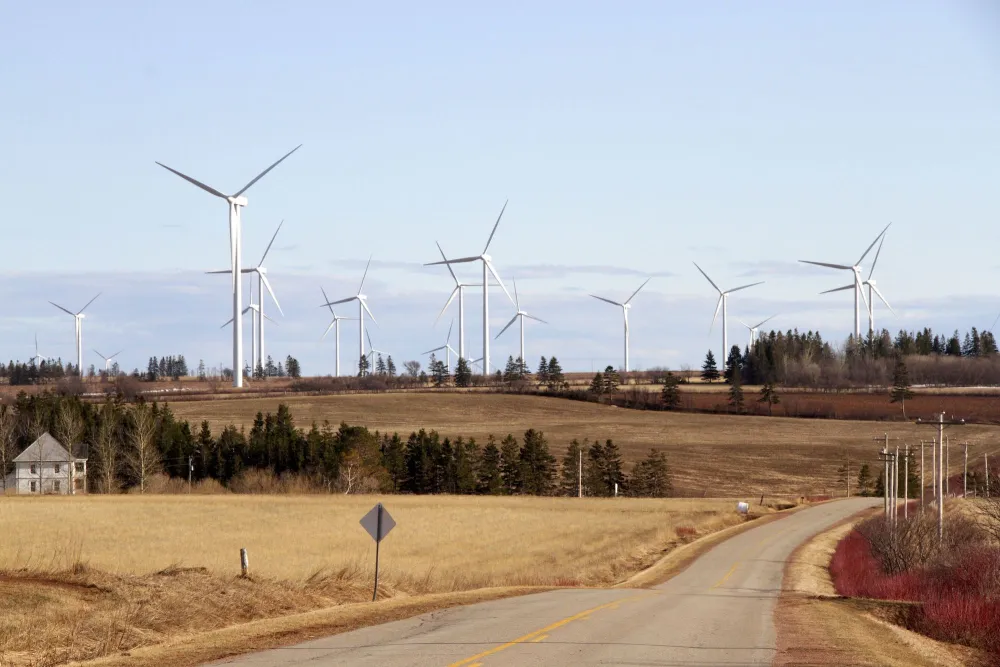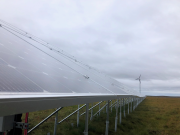Prince Edward Island is the smallest province in Canada. It's known for Anne of Green Gables, mussels, lobster and the "bright red mud" that Stompin' Tom Conners immortalized in his song Bud the Spud, the red earth that grows one-quarter of all the potatoes in Canada. But, perhaps less known — for lack of a catchy theme song — is that P.E.I. also has the highest proportion of wind power of any jurisdiction in North America.
“P.E.I. actually is one of the leaders in wind in the world. 25 per cent of our electricity is produced by wind on Prince Edward Island,” says Paula Biggar, the province's Minister of Energy.
The province lacks a suitable landscape for hydroelectric and has few non-renewable natural resources. So up until a decade ago, the New Brunswick grid provided about 75 per cent of the island's total electricity needs via a pair of undersea cables, while expensive diesel and oil-powered generators made up the remainder of the on-island electricity production.

Wind power in just one decade
When P.E.I.’s government crafted a plan to wean their grid off costly and carbon-intensive diesel, they turned to wind power, one renewable resource that the island has plenty of. A map of the wind resource glows red with high potential across for much of the island. As we write this, 34 per cent of P.E.I.’s electricity is coming from the wind.
P.E.I. began investing in wind generation in 2006, and today has 204 megawatts of wind capacity — not bad for a province that has an average demand of 200 megawatts and a winter peak of 260 megawatts.
The PEI Energy Corporation, a crown corporation, owns three wind farms and 73 megawatts of generating capacity. Engie, formerly known as GEF Suez, owns 108 megawatts of capacity and sells most of its power to New Brunswick through a contract. The Wind Energy Institute has 10.6 megawatts while the City of Summerside also has a 12-megawatt wind farm. Interestingly, almost half of P.E.I.’s wind is under contract to New Brunswick.
Focus on wind power comes down to dollars and cents

“On Prince Edward Island, it costs us five cents per kilowatt hour to produce it (wind power), but we sell it off for eight cents per kilowatt-hour,” says Biggar. “So it is a revenue generator for our energy corporation. We take in about $20 million a year of revenue on our wind.”
That's quite a contrast to diesel generation, which costs up to 45 cents per kilowatt-hour. That's also the reason P.E.I. is pretty keen to find ways of integrating even more wind power. Since building out their capacity, P.E.I. uses its 200 MW of diesel facilities mostly for backup. These days only one per cent of P.E.I.’s electricity comes from on-island diesel generation.
However, P.E.I. has reached a bottleneck with their undersea power cables to New Brunswick.
“We're right in the middle of installing a new cable, a 360 megawatt cable from New Brunswick to Prince Edward Island,” says Kim Horrelt, CEO of PEI Energy Corporation. The $140 million project will provide new baseload electricity capacity as demand grows on the island and it will also allow the continued export of wind power.
How renewable will P.E.I. go?
The province recently decided to delay building a new diesel plant while they seek public input for their new energy strategy. Some wonder if P.E.I. has tapped out the potential of cheap wind energy. But a P.E.I. Energy Commission report in 2012 said: “The potential to advance beyond 30 per cent contractual wind integration and utilize even more of the wind energy generated by all of the wind farms in Prince Edward Island can be realized through time-of-wind electricity consumption initiatives.”
P.E.I. is looking closely at ways of using more wind power through energy storage. A smart grid program in Summerside shows good potential to expand the use of wind power. Meanwhile, Biggar says they are also looking at solar power and more biomass, along with more energy efficiency programs.
Solar one more tool in the clean energy toolbox

The cost of solar is still higher than wind but much lower than diesel, so it may be another part of the puzzle since peak production for solar is midday and in the summer, while the wind blows strongest at night and in the winter. “Whereas wind sometimes is generating in the overnight hours when the demand may not be there…solar is likely to be generating at those peak times of the day when the sun's still out and energy use is high,” says Scott Harper, CEO of the Wind Energy Institute of Canada, founded in 1981 in North Cape, P.E.I.
PEI already has energy efficiency programs aimed at improving efficiency of buildings and of electric heating systems such as air source heat pumps, thermal electric furnaces and water heaters. Consultants advised the province that the cost of energy efficiency is much cheaper than any energy source available to P.E.I.
Energy efficient and electric-powered air-source heat pumps, like the ones we’ve seen in net-zero homes, are being installed across P.E.I. including in the motel where I stayed on my visit.
Integration the key
In a report to the P.E.I. government, Dunksy Energy Consulting outlined the costs of various energy solutions: Energy efficiency, 4 cents/kWh; wind, 6.8 cents/kWh; biomass, 15 cents/kWh; solar, 18.9 cents/kWh; and tidal, 30 cents/kWh. But it’s not a matter of simply picking the cheapest solution. Different solutions provide different benefits and services to the grid. And P.E.I. is already bending the curve through implementation of non-traditional energy storage solutions. The future is not clear, but one thing is certain: P.E.I. appears motivated by early success to push the envelope further.
“If we can get that capacity to store that wind, you would see at least 50 per cent and I think that's our ultimate goal,” says Biggar. “How can we capitalize the most on our wind capacity here on Prince Edward Island? Because that is our greatest resource in terms of potential for electricity. That is the goal we're working towards.”
More than any other jurisdiction, P.E.I. is wrestling with grid design, energy storage and even the structure of their market to build the clean energy grid of the future.










